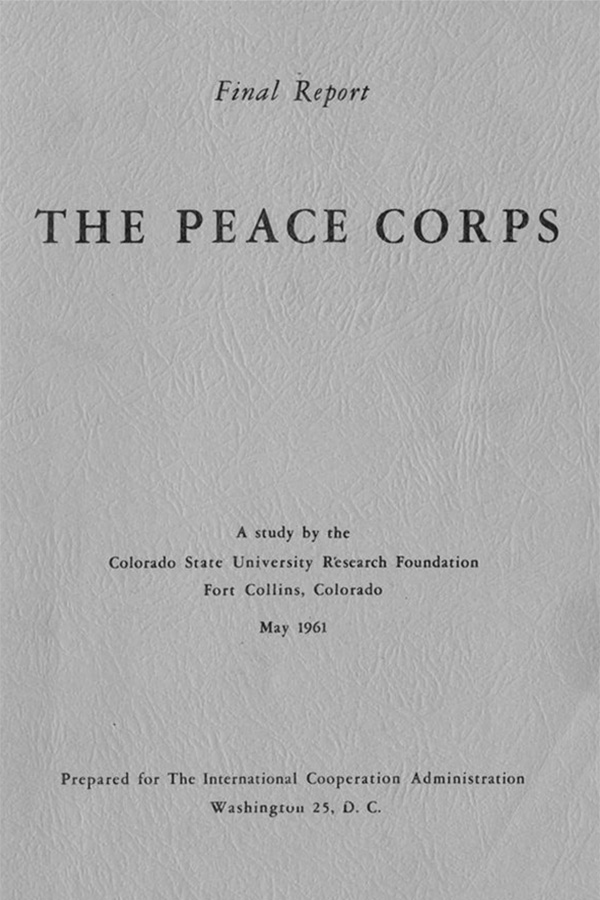A SEED FROM A SHORT SPEECH
Peace Corps roots planted at Colorado State University
story by Nik Olsen
images courtesy of CSU Libraries
published Feb. 20, 2023
A short, early-morning speech by then-presidential candidate John F. Kennedy in October of 1960 led to the signing of an executive order a few months later – and then a call to Colorado State University.
At the Colorado State University Research Foundation, Director Maurice “Maury” Albertson picked up the phone. On the other end of the line was Sargent Shriver, who became the first Peace Corps director. Shriver had a proposal.
“Albertson’s work with the Southeast Asia Treaty Organization and the U.S. Agency for International Development to establish the Asian Institute of Technology in Thailand had, by 1959, stretched the land-grant mission beyond geopolitical boundaries and, fortuitously, into a different sort of international program that will forever bear CSU’s stamp,” wrote Jane Albritton, a Peace Corps volunteer in India and former CSU faculty member who has written extensively on Returned Peace Corps Volunteers (RPCVs).
“Albertson’s interest in international development along with his frequent trips to Washington, D.C., in the late 1950s put him in an information grapevine that had started buzzing about a ‘(Point Four) Youth Corps.’ The idea was to send young Americans to work in developing countries,” she wrote.
Competition for the grant was fierce, according to Albritton, with the likes of Stanford University and the Massachusetts Institution of Technology lurking. But Albertson and Colorado State kept up their efforts in Washington, D.C., to keep CSU in the conversation.
In early 1960, Albertson and CSU received a Point Four (precursor to USAID) contract to prepare a Congressional Feasibility Study of the Point Four Youth Corps called for in the Reuss-Neuberger Bill, an amendment to the Mutual Security Act, wrote John Coyne, a Peace Corps volunteer who spent time in Ethiopia in the 1960s.
Joined by CSU researcher Pauline Birky-Kreutzer, they published a feasibility study that helped lead to the creation of the international development organization.

See the complete text at archives.mountainscholar.org/digital/collection/p17393coll109/id/2337.
“I knew that CSURF was the only organization in the country that could put together the report on ‘the advisability and practicability of the (Point Four) Youth Corps.’ I recruited Pauline Birky-Kreutzer to put together a proposal to get the contract from the State Department. It was only for $10,000,” Albertson said in a 2008 interview with the Northern Colorado Business Report.
Albritton recounted the work.
“Albertson and Birky-Kreutzer’s contract with the State Department called for a detailed study in at least 10 countries on three continents, with a preliminary report due in February 1961. Ever optimistic, Albertson combined a trip to the SEATO Graduate School of Engineering with stops in Pakistan and India. Asia – check. He dispatched Birky-Kreutzer to South America and the Caribbean. Check. With an offer of airfare, he recruited a member of CSU’s philosophy faculty, Manuel Davenport, who had been invited by Albert Schweitzer to attend a workshop in Africa, to do the study on that continent. Check. And done,” she wrote.
Their report became a cornerstone for Shriver’s effort to establish the Peace Corps.

See the complete text at archives.mountainscholar.org/digital/collection/p17393coll109/id/1734.
“So, may it be said that the Peace Corps is a miracle, a little one perhaps, but still a genuine one!” Shriver said in a 1986 speech celebrating the 25th anniversary of the Peace Corps. “For surely it was an intuitive flash of spirit which prompted Kennedy to say to himself: ‘Yes, the idea of a Peace Corps is right. It fits the times. It strikes the right note. It resonates with the concept. People will respond.’”